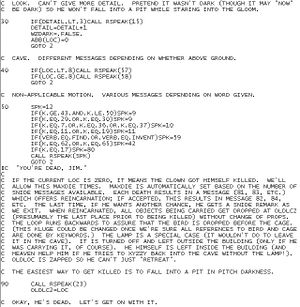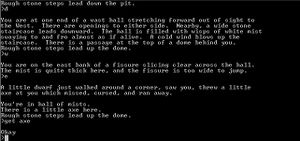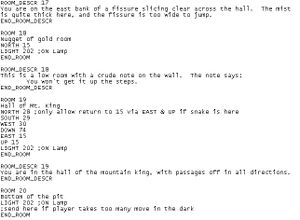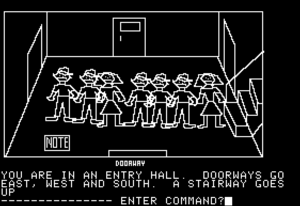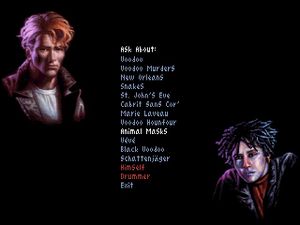Interactive Fiction and Adventure Games
This article was initially published in Today's Engineer on April 2014
Computer gaming can be traced back to the earliest experiments in computer artificial intelligence from the 1940s. The earliest games were primitive adaptations of traditional competitive games such as Nim (1951), OXO (1952), and Tennis for Two (1958). Spacewar! (1962) is often credited as the first commercially successful and widely available computer game, which influenced the next generation of arcade games like Pong (1972) and Gun Fight (1975). Star Trek (1971), Hunt the Wumpus (1972), and dnd (1975) shifted game focus from multiplayer competition to single player problem solving. Following in the path of these titles, 1977’s Adventure gave birth to a new genre, the aptly named adventure game. Adventure games are characterized by their rich interactive single player environment, often with goals of exploring one’s surroundings, solving difficult puzzles, and collecting treasure.
In the early 1970s, Willie and Patricia Crowther were employed by Bolt, Beranek and Newman (BBN). Both were amateur cavers and had extensively explored the Colossal Cavern and Bed Quilt Cave in Kentucky. At BBN, Willie was developing assembly software for the original routers used in ARPANET, and when Willie and Pat had divorced in 1975, Willie wrote a game that he could enjoy with his daughters. The game was based both on his caving experiences and certain fantastical elements inspired by the Dungeons and Dragons tabletop game. Over the 1975-1976 academic year, Crowther wrote the earliest version of Adventure in FORTRAN on BBN’s PDP-10 timesharing computer. While Crowther abandoned development on the game sometime in 1976, the game quickly spread through ARPANET and was discovered by Don Woods of the Stanford Artificial Intelligence Laboratory. In late 1976 or early 1977, Woods contacted Crowther to request his source code, and began work on expanding the game in March 1977. By May of 1977, Woods had greatly expanded the magic, humor, simple combat, and puzzles, of the original game. The Crowther/Woods version was ported to C by Jim Gillogly in later 1977, which allowed it to easily run on UNIX systems, and was widely distributed, and further ported to other systems.
Adventure is able to parse two word commands in VERB – NOUN format; i.e. GO NORTH, GET CAGE, or DROP STICK, although limited to five characters per word (the game instructs the user to use “NE” in place of “NORTHEAST”). As an anonymous Adventurer, the player must explore a vast system of caves, solve puzzles, and collect all the treasure to receive all 350 points. The world is broken down into a number of rooms which are interconnected amongst one another, sometimes in a non-linear fashion, by directional points (N, W, E, S, etc). Rich descriptive text is provided for each room, as well as the various items and entities in them.
Adventure made its way to MIT in 1977, and when a number of hackers including Tim Anderson, Marc Blank, Bruce Daniels, and Dave Lebling had solved the game, they looked for ways that they could improve it. Dissatisfied with the simplicity of FORTRAN, Lebling wrote a parser in MUDDLE, a language that was a successor to LISP, on a DEC PDP-10. The new advanced parser handled more complex sentences beyond a simple two word VERB-NOUN format. The increasingly complex interactions between the player, the world, and its objects eventually took shape into a game much larger than Adventure. This new game was initially called Zork, a nonsense slang word used for unfinished programs meant to be later installed on a computer when in a finished state. The name of Dungeon was decided upon in 1977, but was short lived; Tactical Studies Rules sent the developers a trademark infringement notice, claiming Dungeon bore too much similarity to Dungeons and Dragons, and the name was changed back to Zork.
Zork’s original code in MUDDLE limited its playability to DEC PDP-10 computers. With the rise of personal computers in the late 1970s such as the TRS-80 and Apple II, a large group of computer users could not easily play the game. A FORTRAN port was released in early 1978 by Bob Supnik, a DEC employee who had obtained a leaked copy of the source code. This allowed the game to run across multiple platforms, ironically as FORTRAN was viewed as clunky and limiting by Zork’s initial designers. A custom programming language called Zork Interactive Language (ZIL) was developed in 1979 by Joel Berez and Blank to both port the game easily across multiple platforms, and to serve as a development tool for future games.
Infocom was founded on June 22, 1979, by MIT staff and students, including Blank, Lebling, Anderson and Berez, as a way to provide employment for the Zork developers after their tenure at MIT. Infocom approached Personal Software, Inc. about software distribution in 1980 and the official first release came out for the PDP-11 in November. Due to the large size of the original game’s map, the game had to be considerably reduced for it to run on personal computers. Zork I, roughly half of the original game, was commercially released for personal computers in 1980. Zork II consisted of a continuation of the original game left out of Zork I, along with additional puzzles, and was released in 1981. Zork III, consisting of new puzzles, and some puzzles that had to be left out of the first two games, followed in 1982.
Zork was initially successful, selling 1500 copies on the TRS-80 in 1981 and 6,000 on the Apple II. Dissatisfied with Personal Software’s marketing and distribution, Infocom decided to publish Zork II themselves. Infocom packaged their games with maps, hints and “Invisiclues”, invisible text in the instruction manual that revealed itself when highlighted by a special pen, and rated its games on a difficulty scale of Introductory, Standard, and Expert. Before being bought out by Activision in 1986, Infocom produced 20 games, many now considered classics of the genre, including Planetfall, Suspended, Hitchhikers Guide to the Galaxy and Trinity. While Infocom was the largest and most commercially successful producer of text adventure games, they were by no means the only one. The initial popularity of Adventure and Zork spawned countless text adventure games, developed by professional software companies and independent hobbyists alike. To accommodate the needs of the rising indepdendent game developer, a number of software tools including The Quill (1983), Generic Adventure Game System (GAGS, 1985) and Adventure Game Toolkit (AGT, 1987), were made available to the public. These development toolkits were marketed on simplicity and usability, and allowed people with no previous programming experience to design games that looked and performed like professionally developed games. Much like the games themselves, the only limit to drafting them was one’s imagination, and hundreds of text adventure games were developed using these tools.
In the late 1970s, Ken and Roberta Williams had discovered both Adventure and Zork, but had different ideas on improving these games. The newly introduced Apple II allowed for graphics that were more advanced than other personal computers at the time, and Roberta realized that graphics could supplement text adventure games in a meaningful way. The Williamses founded On-Line Systems in 1979 and began developing Mystery House in 1980. Mystery House used both a text parser and textual descriptions for rooms and actions, but incorporated primitive monochrome line drawings to accompany each scene and was the first adventure game to use graphics. While its parser and textual descriptions were extremely crude compared to Adventure and Zork, the novelty of its graphics made it an instant hit, selling more than 10,000 copies. The Wizard and the Princess, following in the same year, incorporated color graphics, and sold 60,000 copies. On-Line Systems rapidly grew with its success and was renamed Sierra Online in 1982. The company had grown from one employee in 1980 to over 130 in 1983, at which time IBM contacted Sierra to create a game for the new PCjr platform. IBM proposed to fund the game development and advertising, and the resulting game King’s Quest, was released in 1984. It combined animated color graphics and depth perception with an advanced parser. While the PCjr was short lived, its compatible successors made the game a lasting success. To replicate the success of King’s Quest, Sierra developed a toolkit called AGI (Adventure Game Interpreter), which ran all the text, sound and graphics, and allowed for easy porting across various platforms. The AGI games, including King’s Quest, used a parser that included text commands, but also allowed for use of the arrow keys to move the player. Seven official entries followed in the King’s Quest series, and Sierra produced a number of other successful series, such as Space Quest (six games), Police Quest (four games), and Leisure Suit Larry (six games). King’s Quest is Sierra’s most successful series, selling over 3,000,000 total units across its titles.
Sierra used the AGI engine until 1988 when they developed SCI (Sierra’s Creative Interpreter). SCI enabled more detailed 320x200 EGA graphics and extended sound hardware cards. Previously Sierra games relied on the PC Speaker, which was only capable of producing crude square waves; the introduction of Sound Blaster and other sound cards allowed for rich audio and music. King’s Quest IV was the first game released with the SCI engine in September 1988. Inspired by the success of the Macintosh operating system’s move from text control to a graphic interface, adventure games began phasing out text parsers in favor of a graphically based point-and-click interface. One of the earliest successful point and click games was LucasArts’ Maniac Mansion, and with 1988’s Manhunter: New York, Sierra followed in this direction. Sierra continued to move away from basic text parsers and most of the new SCI engine games were completely point and click. By 1993’s Gabriel Knight: Sins of the Fathers, Sierra took full advantage of emerging CD-ROM technology and hired a large cast of Hollywood voice actors including Tim Curry, Mark Hamill, Michael Dorn, and Leah Remini to voice the game’s characters.
By 1993, Sierra had merged with or acquired many other software development companies, had published over 120 titles and their adventure games were at the height of their popularity. During the same year, the immensely popular first person shooter DOOM was released. It and its predecessor, Wolfenstein 3D, marked the emergence of a new genre of game, the first person shooter. These games quickly eclipsed the popularity of the adventure game, which caused the market to shift in different directions. Popularity of adventure games declined, and the late 1990s saw Sierra suffer internal scandals, layoffs, and cutbacks. The company almost entirely ceased to develop new games by 1999. LucasArts similarly stopped production of their adventure games in 2000 and directed their focus towards the rebooted Star Wars franchise.
While the popularity of adventure games has greatly declined in the past decade, they survive in various forms. Visual novels, adventure games often focusing on romance, are extremely popular in the Japanese market, comprising approximately 70 percent of PC game sales. Independent experimental games like Façade and The Stanley Parable have enjoyed viral success, and many elements of role-playing games, including massively multiplayer, online, role-playing games (MMORPG) are inspired by adventure games. In 2007, Zork was determined to be culturally significant and selected by the Library of Congress for preservation. Adventure and Zork paved the way for an entire genre of gaming, while they might appear primitive compared to today’s games, their reputation is duly deserved. Both Adventure and Zork still remain immersive, challenging, and most importantly, fun to play. In a 1983 advertisement, Infocom boasts “We Unleash the World’s Most Powerful Graphics Technology” over a picture of the human brain, and the images evoked by Zork’s descriptions of underground dungeons, caves, wizard and trolls are just as engaging today as they were thirty years ago.
Further Reading and Downloads
Colossal Cave Adventure Page - http://rickadams.org/adventure/ - History, discussion, and numerous downloads for the Crowther/Woods classic
Infocom Downloads - http://www.infocom-if.org/downloads/downloads.html - Free downloads of Zork I, Zork II and Zork III Anderson, Tim, (1985), “The History of Zork”, New Zork Times, Winter, Spring, Summer, 1985. http://www.ifarchive.org/if-archive/infocom/articles/NZT-Zorkhistory.txt
Jerz, Dennis G., (2007), “Somewhere Nearby is Colossal Cave: Examining Will Crowther's Original "Adventure" in Code and in Kentucky”, Digital Humanities Quarterly, Vol 1, no. 2. http://www.digitalhumanities.org/dhq/vol/001/2/000009/000009.html
Holmberg, Petter, “The history of Sierra Entertainment“. http://www.oocities.org/petter_holmberg/historymain.html
